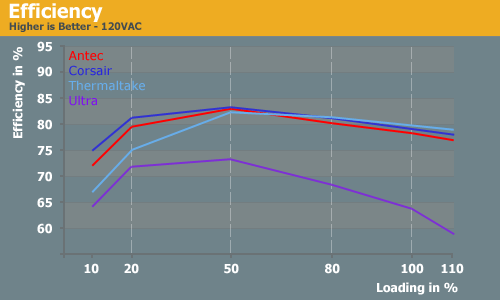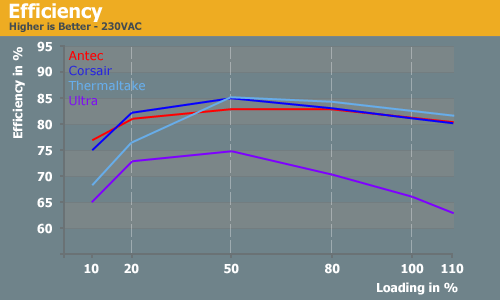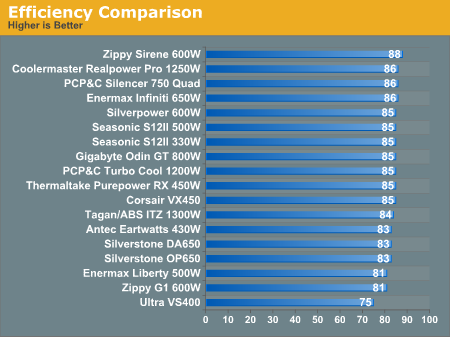400-450W PSU Roundup
by Christoph Katzer on November 6, 2007 4:00 AM EST- Posted in
- Cases/Cooling/PSUs
Comparison and Conclusion
Let's come to the interesting part of performance. The output stability has been quite similar from the three higher-end units. Thermaltake looks a little better than the others do, but all are well within specs. Ultra ends up as a very low-end unit and the results clearly show this better than any words.


In the area of efficiency, the Antec and Corsair units take the lead again. Both are at 80% efficiency starting with loads of around 90W while the two other are at 76% and 73%. The components in the Corsair PSU seem to be slightly better than the cost-reduced Antec PSU, as evidenced by the 1% higher efficiency. Still, 1% higher efficiency should not be the only reason for buying this unit since there are so many other points to keep in mind. Thermaltake does achieve a high 85% efficiency with a medium load of 225W as well.

In terms of connectors, the Corsair clearly has the most options and is the best-equipped PSU of the bunch. There are six Molex and six SATA connectors attached to four harnesses with a minimum length of 30cm and a maximum length of just 60cm. The ATX connector, PEG and CPU connectors have a length of 60cm as well which is nice and long. The corsair is the only unit today with an 8-pin EPS connector (not that it's really necessary for a 450W PSU).
When it comes to prices, it's no shock that the Ultra is the cheapest (by far!) of the four tested units, with prices as low as $40US. The V-Series 400W is not available in Europe because of the missing PFC. The Antec Earthwatts 430W comes next, with prices starting at $60. That may be 50% more than the Ultra, but we hope it's now clear that this is money well spent. Corsair and Thermaltake come in as the most expensive of this batch, with the Corsair 450VX selling for around $78 and the Thermaltake Purepower 450W going for a few dollars more ($84).
After looking at the test results, one of these power supplies clearly rises above the rest: the Corsair 450VX. It provided the best overall performance, it wins in the area of connector options (though not by a large amount), and it also provides the lowest noise levels. It's not perfect, as heatsink temperatures were still a bit higher than we'd like under stress conditions, but if you're after a high quality, moderate wattage power supply this one definitely ranks above the rest. The price is even acceptable. If you'd rather spend less than $60, while the Earthwatts isn't bad, we'd probably just go back to the source and pick up a Seasonic 380W unit.
Let's come to the interesting part of performance. The output stability has been quite similar from the three higher-end units. Thermaltake looks a little better than the others do, but all are well within specs. Ultra ends up as a very low-end unit and the results clearly show this better than any words.


In the area of efficiency, the Antec and Corsair units take the lead again. Both are at 80% efficiency starting with loads of around 90W while the two other are at 76% and 73%. The components in the Corsair PSU seem to be slightly better than the cost-reduced Antec PSU, as evidenced by the 1% higher efficiency. Still, 1% higher efficiency should not be the only reason for buying this unit since there are so many other points to keep in mind. Thermaltake does achieve a high 85% efficiency with a medium load of 225W as well.

In terms of connectors, the Corsair clearly has the most options and is the best-equipped PSU of the bunch. There are six Molex and six SATA connectors attached to four harnesses with a minimum length of 30cm and a maximum length of just 60cm. The ATX connector, PEG and CPU connectors have a length of 60cm as well which is nice and long. The corsair is the only unit today with an 8-pin EPS connector (not that it's really necessary for a 450W PSU).
When it comes to prices, it's no shock that the Ultra is the cheapest (by far!) of the four tested units, with prices as low as $40US. The V-Series 400W is not available in Europe because of the missing PFC. The Antec Earthwatts 430W comes next, with prices starting at $60. That may be 50% more than the Ultra, but we hope it's now clear that this is money well spent. Corsair and Thermaltake come in as the most expensive of this batch, with the Corsair 450VX selling for around $78 and the Thermaltake Purepower 450W going for a few dollars more ($84).
After looking at the test results, one of these power supplies clearly rises above the rest: the Corsair 450VX. It provided the best overall performance, it wins in the area of connector options (though not by a large amount), and it also provides the lowest noise levels. It's not perfect, as heatsink temperatures were still a bit higher than we'd like under stress conditions, but if you're after a high quality, moderate wattage power supply this one definitely ranks above the rest. The price is even acceptable. If you'd rather spend less than $60, while the Earthwatts isn't bad, we'd probably just go back to the source and pick up a Seasonic 380W unit.










37 Comments
View All Comments
opterondo - Sunday, November 18, 2007 - link
You all do understand that a 1000w PSU doesn't use 1000w right?For instance you hook up 333w peak load worth of components to it it will use ~333w.
The only reason to buy a smaller capacity PSU is up front price and possibly better AC-DC conversion efficiency (like maybe 70% instead of 60%)
opterondo - Sunday, November 18, 2007 - link
Good thing they didn't review any of the COOLMAX PSUs cause they are fairly priced and out perform most any in this article.COOLMAX CX-400B ATX v2.01
COOLMAX CP-500T EPS12V
COOLMAX CXI-500B ATX12V
COOLMAX CUG-700B ATX 12V( V.2.2)
mindless1 - Thursday, November 15, 2007 - link
Months ago I was almost given a vacation in the forums because of shills and naive owners that wouldn't accept my negative comments about Ultra V-Series. I feel a bit vindicated and yet the review didn't even touch in it's primary weakness, poor capacitors leading to poor lifespan even in a system it would be suited to run in.I do have to disagree about one aspect of the review in that the Ultra does have PFC just not active or APFC, and an "old" passive PFC design is not a big deal, a PSU can run fine w/o AFPC and historically there were plenty of decent, not just cheap, PSU with passive PFC evidenced by the input voltage selection switch.
Also in the reviews, please mention the fans' make model and bearing(s) type as they are also weak links when cheap sleeve-bearing types are used.
Kougar - Friday, November 9, 2007 - link
On many of the pages I am seeing empty image placeholders that link to 0x0 pixel images that are 1.5KB in size... someone might want to fix that. :)Christoph Katzer - Friday, November 9, 2007 - link
Working fine here ;)Kougar - Wednesday, November 14, 2007 - link
Do you work for Anandtech???Since an image is worth a thousand words: http://i111.photobucket.com/albums/n129/Chanur64/M...">Image Link
The "missing" ghost image placeholder shows up for every PSU info page.
Christoph Katzer - Thursday, November 15, 2007 - link
Oh yep thanks. Now it's working.grantschoep - Thursday, November 8, 2007 - link
Low end power supplies?I want to to know who the heck needs a 500+ watt power supply that isn't running some crazy dual SLI setup. I really wish power supply makers would focus on quite and very stable/clean voltages.
I wish companies would really focus on very high quality low end systems. 98% of us don't need a 500+ watt power supply. 90% of us don't need a motherboard with as much crap as they tack on(2 1gig network ports for example)
As an electrical engineer, 1 US dollar extra.... could by much better caps and the like.
Heck as a further annoyance, when company A has a PSU fan that is better/quiter than another, why go whit the lesser
I really wish that companies would focus on this. I don't need a 1 KW beast. I want a good, high quality ~450 watt supply that is nice and quite.
erple2 - Thursday, November 8, 2007 - link
I am a bit saddened by the (IMO) relatively unimportant temperature of the heatsinks, or sound ouput. IMO, the single most important measurement of the usefulness of a power supply is, in fact, it's ability to supply power.I would equate evaluating it's value on thermal and acoustic characteristics to evaluating the superiority of a GFX card on it's thermal characteristics. For that effect, my old Matrox Millenium card destroys an 8800GTX.
Seriously, I'd really like to see much more in-depth analysis and evaluation on the stability of the power generation, the cleanliness of the signal, the resistance to sagging based on varying the power requirements, etc.
I understand that acoustics and thermals are important, but they're really secondary to the actual performance of the power generation. If you're overly concerned with the loudness of a power supply, or how hot it gets, instead of the actual performance of the power supply, then maybe you shouldn't be using a computer..
Christoph Katzer - Friday, November 9, 2007 - link
Did you just read the comparison or?